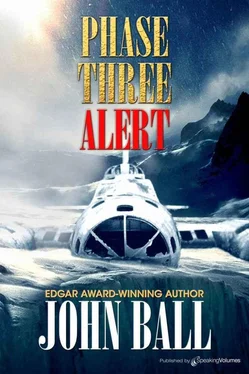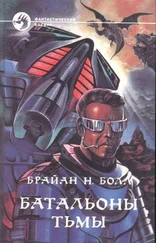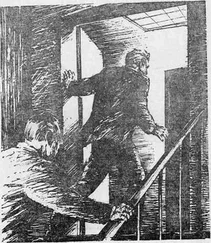“Beautiful, isn’t it,” Seligman said.
“Damn right it is,” Ferguson agreed.
He was in his own cockpit during the pre-engine-start checklist when the second Det. 4 Jolly Green Giant taxied past. He saw Mike Turner in the left-hand seat with Major Mulder on his right. Sergeant Prevost was framed in the open doorway.
Three minutes later the Hercules airlifter was fully alive, hurling its own song of power across the field. The second HH-3 lifted off the end of the runway, poised a few feet off the ground, and then began a stiff climb toward the ice cap, turning as it went.
Ferguson released the brakes and began to taxi. As the C-130 rolled slowly down the ramp, his hands gripping the yoke, he wished that he had the power to tell the Penguin that they were all coming.
His own takeoff was a thing of beauty that would have brought joy to the heart of Orville Wright. Then it was up to Lieutenant Jenkins: he had to find what was left of the Penguin on the ice cap, and the last phase storm might have completely covered it with loose snow.
Jenkins delivered; he missed his ETA by less than two minutes and his final heading was almost exactly dead on. Ferguson circled the landing area once to be sure that all was well, then he put the skis down, set up an approach, and watched the snow come closer. The markers had been obliterated, but they were not needed. He raised the nose of the Hercules a few degrees and slid it onto the ice cap at something around a hundred knots with absolute ease.
He was taxiing when Sergeant Feinberg appeared on the bridge. It was a breach of proper discipline, but Ferguson understood that there would be a valid reason.
“Sir,” Feinberg made himself heard, “if you could possibly turn her ninety degrees when you’re spotted, it will make the loading job a helluva lot easier.”
“Right,” Ferguson agreed. Two hundred feet farther on he revved up the starboard engines and swung the turboprop around in a quarter circle. When he stopped, the rear loading ramp was facing squarely toward the remains of the derelict bomber. He shut down the power and secured the flight deck. As he climbed into his parka and arctic gloves, he was glad for the moment that he hadn’t been chosen as an astronaut after all.
When he reached the main hold, he saw that the rear ramp was already open; the driver of the snow tug was about to start up his machine. For the last time Ferguson went outside and began to walk across the ice cap toward what remained of the old B-17. The forward fuselage section concerned him most; it contained all of the essential controls and was by far the most intricate and essential component of the original airplane. It was its heart and being. It was about to be loaded into his C-130 and he wanted to take part in that operation.
It began almost at once. Sergeant Feinberg, who was in clear command of the first stage, signaled the snow tug into position just in front of the open hole that had been left when the fuselage had been divided into its forward and aft sections. Ropes were run inside and secured to the heavy structural members just above the center section of the wing. The job was made slightly more difficult because a considerable quantity of snow had been blown inside; since the whole forward section was almost half full, it made the entire recovery job look more hopeless than it had at any time in the past.
Even the cockpit had a full foot of snow; when Ferguson went up there to check it out his heart sank — the frigid, frozen controls all but mocked him with their immobility. He understood the terrible toll that three decades of ruthless exposure must have inflicted on delicate instruments and other moving parts.
He recognized the temptation of the Devil and purged it from his mind. The B-17 was a fine, beautiful airplane — the only thing wrong was that it needed some maintenance.
He felt the deck begin to rock gently under his feet; he turned and began to wade through the snow back toward the open end so that he could witness and participate in everything that was going on. The ropes had been attached to the snow tug and were already pulled taut preparatory to movement. As Ferguson came out he saw that some ten men were on each side of the fuselage sections ready to add muscle power as soon as it was needed.
Feinberg checked the ropes and then issued a directive. “Rock it about fifteen degrees each way for half a minute; that’ll make sure that it’s loose and will form a trough for it to slide in.” In response, carefully controlled force was applied first to one side and then to the other; The Passionate Penguin stirred in her long sleep.
“Now!” Feinberg shouted and pointed vigorously toward the snow-tug operator. The tracks of the powerful little vehicle bit more deeply into the snow, the ropes came tighter still, and the heavy fuselage section began to slide slowly backwards. When it had built up a speed of two miles an hour, the tug driver began a slow turn.
With massive dignity the nose section of the Penguin started to describe a slow arc around the horizon. Ferguson ran forward and joined the long row of men who were helping to push and to guide. Within five minutes the fuselage section was precisely lined up with the rear loading ramp of the C-130. At that moment, without visible sign, the control of the operation passed to Sergeant Stovers, the loadmaster.
He knew precisely what he was going to do. “I need a twenty-degree tilt,” he ordered. “It’s going to have to go in diagonally to get enough clearance. Otherwise I’ll be two inches shy.”
In response to his instructions the section was rocked once again until it was sufficiently over on its side. Ferguson reached up and patted the almost obliterated design that had once adorned the bomber’s nose. “Hang in there, baby,” he said very softly. “You’re going home.”
The snow tug dropped the lines and pulled to one side. As it did so, Stovers raised the loading ramp of the airlifter until it was in an exactly level position. “Now build me a snow bridge,” he told the tug driver. “I’m going to need at least thirty level feet.”
The tug operator flipped his gloved hand in the air to indicate how simple it would be and pulled a lever. The blade of his machine scraped up a heavy roll of snow and pushed it into position just under the edge of the raised ramp. Then the driver backed to begin another pass.
Ferguson watched him place one more load and then walked away; it would be at least half an hour before anything else could be done. When he had covered a hundred yards he stopped and let the stillness of the ice cap prevail. The sounds of the working tug were already well in the background. Measured against the immensity of the thing on which he stood the tiny bit of activity he had just left was infinitesimal.
When he had experienced his fill he went slowly back, deliberately letting the minutes pass. The snow tug was still snorting away, but the snow ramp was close to completed. The driver was running his machine across the top of his forty-foot-long creation, making sure that there were no soft spots that might give way. The snow ramp was precisely lined up with the back of the C-130 and just a little higher than the ramp proper, making it possible to get the long fuselage section straight into the waiting hold of the airlifter that could just barely accommodate it.
Lines were passed inside and through pulleys that Stovers had already rigged close to the forward bulkhead. When they came back out again, they were secured to the tug that was now positioned just beside the snow bridge. To Ferguson the progress after that was agonizingly slow, like watching a great aircraft carrier warp into its dock. Inch by careful inch, the tug backed on signal, tightening the ropes and drawing the nose section of the bomber cautiously forward. It took a full ten minutes to position the section entirely on the snow bridge with its open end less than two feet from the entrance ramp of the C-130.
Читать дальше












